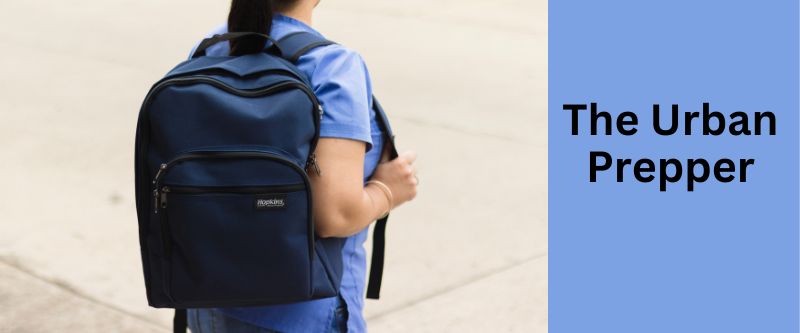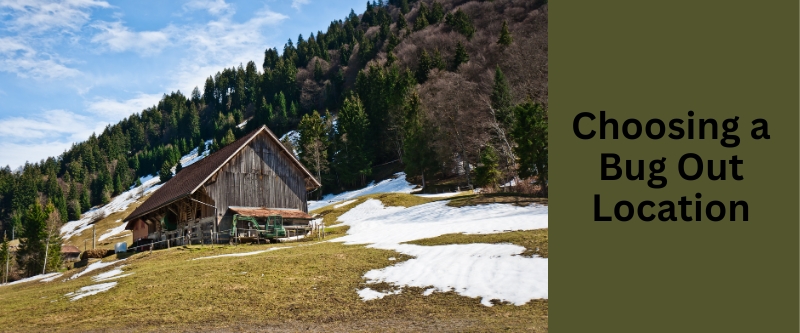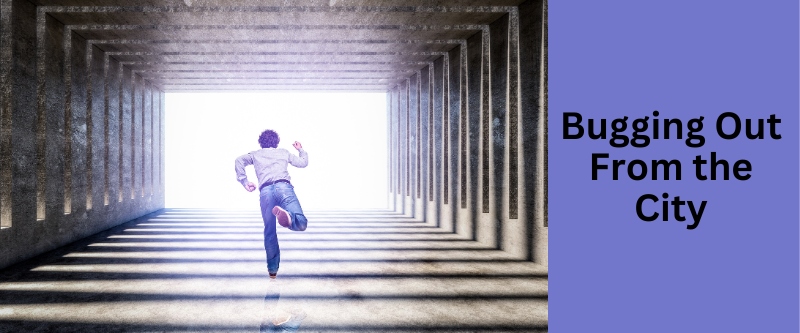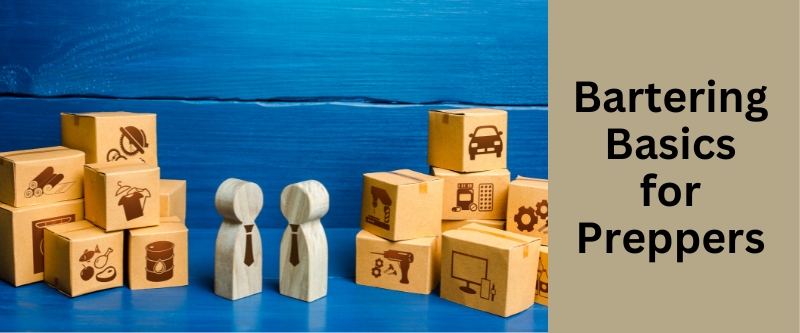Table of Contents
The urban prepper needs to understand shelter as part of the basic human survival triad. This is food, water, and shelter. In adverse situations having permanent shelter, which is a safe place to stay and protected from the elements, can make the difference between life and death.
The Shelter Spectrum
But not all permanent shelter is created equal. And in a survival or SHTF scenario, there is a spectrum of vulnerability.
At one end of the spectrum, you have the urban or apartment shelter, which is the most vulnerable. Then you have suburban shelter. After that, you have rural shelter, which, in our opinion, is ideal.
At the other far end of the spectrum, you have the semi-mythical BOL or bug-out location. This is located in deep wilderness and has its own set of vulnerabilities.
The Most Vulnerable Shelter
Of course, if you are a bugged-out SHTF refugee, attempting to move from one permanent shelter to another, you have to survive in a temporary shelter. This is what you carry with you or improvise along the way. This type of shelter is the most vulnerable of all.
Urban Shelter
There are aspects unique to urban shelter that make it different from and more vulnerable than suburban or rural shelter.
Population Density
Urban areas are densely populated. This leads to competition for resources. In a crisis, this can result in shortages of food, water, and other essentials. This in turn creates a panicked population that presents its own danger to the individual, especially one seen as having resources to plunder.
Limited Resources
Cities rely heavily on a constant inflow of resources. If supply chains are disrupted, urban areas can quickly run out of essential goods.
Infrastructure Dependency
Urban residents are more dependent on public utilities such as water, sewer, natural gas, and power. Disruptions to these services can have immediate and severe impacts.
Limited Mobility
In a crisis, urban areas can experience gridlock, making it difficult for residents to evacuate. This is especially true for apartment dwellers who might not have immediate access to a vehicle.
Higher Crime Rates
Cities have higher crime rates than rural areas. In a crisis, there’s a potential for an increase in looting, violence, and other crimes.
Lack of Self-sufficiency
Urban areas have limited space for activities like gardening or raising livestock. This makes city dwellers more dependent on external sources for food.
Exposure to Hazards
Due to the concentration of industries, transportation systems, and large populations, urban areas are more susceptible to hazards like chemical spills, terrorist attacks, or other man-made disasters.
Limited Escape Routes
In case of a need to evacuate, densely populated urban areas have limited routes out, leading to congestion and a trapped and panicked population.
Lack of Community Cohesion
While not always the case, urban areas lack the tight-knit community feel of rural areas. This affects mutual aid and support during crises.
Limited Space
Apartment dwellers usually have limited space to store emergency supplies, making it challenging to prepare for extended emergencies. This lack of space also makes an extended “bug-in” period extremely difficult. And it is made worse by the collapse of utilities, especially the sewer system.
Urban Shelter Prepping
Here’s how the urban prepper should approach the topic of shelter:
The Gray Man Strategy
In a survival or crisis situation, the ability to go unnoticed gives you a strategic advantage. The Gray Man strategy revolves around blending in with the crowd, ensuring you’re easily overlooked, unnoticed, and forgotten. And this is not just about physical appearance. It is also about behavior, demeanor, and even the energy you project.
Urban Camouflage
A Gray Man or Woman is someone who wears metaphorical urban camouflage. He or she moves freely in potentially hostile or challenging environments without drawing attention.
Why Adopt the Gray Man Approach?
There are numerous scenarios where standing out can be detrimental. In a crisis, if you’re perceived as someone with supplies, tools, or valuable resources, you risk becoming a target for the desperate or opportunistic. And there will be plenty of those in a SHTF scenario.
Similarly, if you appear calm when others are panicking, they might expect you to lead, which can be against your interests. The Gray Man approach helps you avoid these complications.
How to Be a Gray Man or Woman
Appearance
Dress neutrally, avoiding bright colors or conspicuous attire. Your goal is to look like an average member of the crowd. This might mean dressing down. Certainly, avoid tactical gear and visible weapons. And don’t flaunt bling.
Your Car
Having an expensive car is nice but it destroys your Gray Man persona. And it tells the world that you likely have stuff that is worth going after.
Behavior
Adopt a demeanor that doesn’t attract attention. This includes avoiding sudden movements, loud conversations, or any behavior that might make you memorable.
Emotional Control
Emotions can draw attention. Whether it’s fear, anger, or even excessive joy, strong emotions can make you stand out. Learn to control and mask your feelings to blend in better.
Awareness
While you want to blend in, you should also be hyper-aware of your surroundings. Use peripheral vision, avoid direct eye contact, and be conscious of potential threats or disturbances.
Adaptability
Depending on the situation, the definition of a “Gray Man” might change. In some scenarios, a business suit might be the best disguise, while in others, rugged outdoor clothing might be more appropriate.
For the prepper, it is a good idea to be a bit of a Gray Man in any setting. But it is especially important in an urban environment.
But, Wait a Minute!
Isn’t this all a bit contrived and a lot of hard work? Yes. But we’re just telling you like it is. You have to make your own assessment.
The point is that in an SHTF scenario, the biggest threat to you in an urban environment is your fellow human being, not thirst, hunger, or the weather.
Location Assessment
The first step in urban prepping is to assess the location of your urban dwelling. Is it in a high-rise building, a mid-rise, or a ground-level structure? Each type has its own set of challenges. High-rises, for instance, are more vulnerable to events like fires, and evacuating them is more difficult.
Security
Urban areas tend to have higher population densities, which can lead to increased risks during emergencies. Ensure that your shelter has reinforced doors, windows, and other entry points. Consider Installing security systems and surveillance cameras.
Windows
Pay special attention to windows. Part of being a Gray Man is maintaining anonymity. And in the SHTF scenario, you want to vanish. So put blinds/blackout curtains on the windows, along with window security film. This will block the view of your apartment from the outside and it won’t look as though anyone is living there.
And it’s a good idea to have on hand the wherewithal to board up your windows, especially if you have a ground floor location.
Water and Food Storage
Space is usually limited in urban settings. Get creative with storage solutions for water and food. Under beds, in closets, and even behind sofas are potential storage areas.
Urban Gardening
Yes, there is such a thing, using aeroponics and hydroponics in a window farm, for example. And it can certainly supplement your food supply.
But, in our opinion, this is more of a hobby project than a practical prepping proposition. Plus, certainly, in an apartment, you are better off using the space, time, and effort to store and maintain supplies.
If you have a city house with a yard, you have more options. But even so, there is always the problem of the water supply going down And that can put an end to your gardening project right there.
Backup Power
Power outages can be more frequent in cities due to the high demand. Consider having backup power options like portable generators, solar panels, or battery banks. Again this is more of an option if your city home has a yard. It’s hard to make this work in an apartment.
Community Networking
In urban settings, community can be a strength. Building a network of like-minded neighbors can be beneficial. It can be a source of support, information, and resources during emergencies.
But balance this against the advantages of being an anonymous Gray Man.
Escape Routes
Always have multiple escape routes planned. This includes not just routes out of your dwelling, but also out of the city. Urban areas can become congested quickly during mass evacuations. Hone your street smarts.
Noise and Light Discipline
In an urban crisis scenario, drawing attention can be dangerous. Be mindful of noise and light emissions from your city apartment or home. We have already mentioned blackout curtains. So consider the addition of soundproofing.
Specialized Gear
Given the unique challenges of urban environments, having specialized gear like crowbars (for forced entries or exits), smoke hoods (for escaping fires in high-rises), or even rope ladders (for evacuating from upper floors) can be crucial. We list apartment prepper gear below.
Critical Vulnerabilities of Apartment Prepping
In a short-term emergency, the urban prepping scenario is no different than for anywhere else. You just need sufficient supplies on hand to get you through a few days or a couple of weeks tops, until things settle down and get back to normal. And with a bit of luck, all the utilities continue to function.
A Rock and A Hard Place
But in a true SHTF scenario, the urban prepper is between a rock and a hard place.
Say you have been holed up in your apartment for a couple of weeks, enjoying the relative comfort and safety of a mini fortress. But now your fortress has become a rock because your utilities have been shut down, you have run out of supplies, and your only option is to bug out or starve to death.
But as soon as you step outside your apartment you run into the hard place of urban survival. You enter a storm of street violence, a world of chaos and panic, where hungry and feral mobs roam the streets and you stand a good chance of getting mugged or worse for what you carry.
Takeaway
So what is the main takeaway? Two weeks of supplies just doesn’t cut it. You need to be self-sufficient in your apartment for much longer than that. You need time for the chaos and panic outside to subside or otherwise resolve itself. This is in the hope that things will return to normal in a few months. Or at least hope that you will be able to bug out in relative safety by then.
Now food and water are not a problem in and of themselves. You face two main issues – space and waste.
Space
You need adequate space in your apartment to store all the food and water you need for an extended period. Plus you want to be able to lead a normal life in the meantime. This is hard to do if every nook and cranny of your apartment is dedicated to food and water storage.
Waste
You need some way to deal with the human waste that all that food and water inevitably generates. This second problem is actually your main issue. It is what literally puts the shit in SHTF. Check out what actually happened in Auckland, New Zealand.
If the utilities are down, the sewage system goes down too. And toilets don’t work. They even overflow under pressure from the apartments overhead. So what do you do? You can’t toss the stuff out of the window medieval (gardyloo) style. After all, you are trying not to draw attention to yourself.
There are only two human waste disposal systems that we know of that will work for an apartment. And neither of them is good for the long term.
Composting Toilet
Nature’s Head (needs a 12-volt supply). There are other composting toilets available but we have no experience with any of them.
Camping Toilet System
In this solution, you combine the trusty 5-gallon bucket or this Camco Portable Toilet Bucket with a toilet seat made for the purpose. You combine it with a toilet waste bag.
You then store the waste bags in a separate bin. And you can try to manage the stink with this toilet deodorant or similar.
If your urban living is in a house with a backyard, you have better options, such as a simple outhouse.
Bottom Line of Urban Prepping
In a long-term SHTF scenario, apartment living is just not sustainable. If you have a city home with a backyard, you have more latitude, provided you manage to survive the looting of the street mobs passing by outside your front door. But nonetheless, you will likely need to bug out eventually.
Gear and Supplies for an Urban Shelter
Please read this list to include the toilet solutions mentioned above and the gear designated for your bug-out bag (see further below).
Food & Water Storage Solutions
Look at your options, such as under-bed storage, wall-mounted shelves, and multi-purpose furniture. Design your water storage and food selections around the space available for them.
Water
Water bricks and collapsible water containers make for the most sensible apartment water storage. You don’t want to draw attention to yourself by dragging in water barrels. Add water purification tablets and portable water filters. Get a Sillcock water key to give you access to apartment and commercial building water faucets (assuming the water is running) and remember to put it in your bug-out bag
Food
Also remember that your urban stay in a major SHTF scenario, which could make the city uninhabitable, is going to be limited in duration. So it is pointless to lay in a supply of rice and beans packaged to last for 25 years. You don’t want to be bugging out and leaving that behind in a rented apartment.
Reinforced Doors and Windows
Consider security doors and shatterproof window films. Consider portable door locks.
Noise and Light Discipline
Blackout curtains, soundproofing materials, and low-light lanterns.
Escape Gear
Rope ladders, crowbars, and smoke masks. Emergency services may not be operating.
Fire Safety Gear
Fire extinguishers, smoke hoods, and fire blankets.
Power
It’s unlikely that a portable generator is an option in an apartment. But solar panels in a window are a possibility, combined with battery banks.
Communication Devices
Hand-crank radios, emergency whistles, and two-way radios.
Personal Protection
Pepper sprays, personal alarms, and self-defense weapons.
Community Networking Tools
Community board, contact list of neighbors, and local maps. But remember the Gray Man strategy.
Books and Entertainment
Books, card games, and board games pass the time and reduce stress and boredom. And here’s a book to get right now: Urban Prepping 101 for Families and Beginner Preppers.
The above list provides a starting point for urban preppers. It’s really a memory jogger. Each situation is different and the prepper must make his or her own assessment and adjust the list accordingly.
Bugging Out
But eventually, there may come a time when your urban shelter becomes untenable and you must bug out. So below we offer a list of specific bug-out gear tailored for the urban apartment dweller.
Remember that what you put in your bug-out back can also be used before that event. Avoid needless duplication and keep a checklist. So when it does come time to bug out, you remember to put it in the bag.
Family Bug Out
But first, here is some general advice on packing bug-out bags, especially when family is involved.
Understanding the Bug Out Mission
Before packing, understand your mission. Know your starting point, destination, the challenges you’ll face, and what awaits you at your destination. And especially know your distance and how long you expect to be on the road. This will guide how you pack your bug-out bag.
The Gray Man’s Bug Out Bag
We have discussed the concept of the “gray man.” Instead of appearing tactical, aim to blend in. Your gear should be unassuming to avoid drawing attention. Choose earth-toned bags that look worn and not overly tactical.
Distance Determines Size
The distance you plan to travel determines the size of your bug-out bag. Sizing is measured in liters (L) of capacity.
- Short Distance (Up to 10 miles): Smaller bags suffice. Example: Ready Pack 2.0 by Vertx.
- Medium Distance (10-20 miles): Requires a slightly larger bag. Examples: 72-Hour Assault Pack from Condor or the Paratus from 3VGear.
- Long Distance (20+ miles): Requires a substantial bag, like a 50L or greater, to accommodate multiple days’ needs. Examples: 60L Osprey or High Sierra
How Much Gear Can You Really Carry?
The rule of thumb is that a person can carry a pack that is 25% of their body weight. And this is fine so far as it goes. But it assumes a level of fitness that many people just do not have.
For example, a 200-pound man can reasonably backpack a 50-pound load. But how far can he walk with it, if he hasn’t packed it before and hasn’t done much recent walking anyway? Not far, trust me.
Importance of Training
If you are serious about being able to bug out on foot successfully, you must train for it. So must your family. Also, remember that maintaining fitness requires regular training.
Pro tip: Turn training into fun for the family. Take camping trips and do some bug-out simulations.
Weight of Water
One gallon of water weighs about 8.5 pounds. So, at one gallon per day per person, a three-day supply of water weighs about 25.5 pounds. That is half of the man’s 50-pound load we just mentioned.
This is why it’s important to know your route. Can you realistically expect to find water along the way? If so, that can affect how much water you need to start out with.
Personalized Gear
Consider personal needs and the environment. For instance, bug spray for swampy areas or sunscreen if you expect significant sun.
Packing Priorities
Pack items you’ll access frequently at the top or in easily accessible pockets. Examples include maps, compass, optics, water, food, and communications.
Other Packing Tips
- Keep it Efficient: Only pack essentials to save on weight and space.
- Leave Extra Room: This allows for unexpected additions.
- Use Your MOLLE: MOLLE webbing on bags allows for external attachments, saving internal space.
- EDC (Everyday Carry) Help: Tactical pants or jackets can hold essential items, reducing the need for a larger bag, and allowing quicker access.
Men’s Bug-Out Bag
Purpose: Typically, the heaviest and most comprehensive bag, and designed to carry essential tools, shelter items, and heavier gear.
- Tools: Multi-tool, knife, paracord, firestarter, flashlight, and batteries.
- Shelter: Compact tent or tarp, sleeping bag, and ground pad.
- Clothing: Durable clothing, waterproof jacket, hat, gloves, and sturdy boots.
- Food & Water: Water filter, portable stove, freeze-dried meals, energy bars, and a stainless-steel bottle.
- Navigation: Compass, map, GPS device.
- Protection: Depending on local laws, a firearm or alternative self-defense tool.
- Miscellaneous: First-aid kit, personal documents, cash, and communication devices.
Women’s Bug-Out Bag
Purpose: Balanced between personal essentials and shared family items.
- Personal Care: Feminine hygiene products, personal medications, and toiletries.
- Clothing: Lightweight clothing, waterproof jacket, hat, gloves, and comfortable shoes.
- Food & Water: Snacks, energy bars, water purification tablets, and a collapsible water container.
- Child Care: If applicable, baby food, diapers, and comfort items.
- Protection: Personal alarm, pepper spray, or other self-defense tools.
- Miscellaneous: First-aid items, personal documents, cash, and a compact flashlight.
Children’s Bug-Out Bag
Purpose: Lighter and tailored to the child’s age and capability, focusing on comfort and essential personal items.
- Clothing: Spare clothes, hat, and lightweight jacket.
- Comfort: A small toy, book, or game for distraction and comfort.
- Food & Water: Snacks, a refillable water bottle, and perhaps a favorite non-perishable treat.
- Protection: Whistle, small flashlight, and a personal ID card with emergency contact details.
- Miscellaneous: A lightweight blanket, wet wipes, and any essential medications.
Review
Review the contents of each bag periodically and adjust them based on changing needs, especially for growing children. Also make sure each family member is familiar with the items in their bag and knows how to use them.
Remember, the primary goal of a bug-out bag is to support an individual or family during a 72-hour period of displacement. It should be tailored to the specific needs and circumstances of each family member and the expectations of the journey.
Low Key Bug-Out Bag
Remember the Gray Man. Within the above constraints Choose a bag that is inconspicuous and doesn’t scream “prepper.” It should be comfortable, durable, and have enough compartments for organized storage.
Urban Bug-Out Bag Checklist
This bug-out check list is oriented towards the urban prepper. We have another checklist here.
Cash
In small bills. The ATMs are likely not working.
Water Filtration System
A portable water filter like the LifeStraw or Sawyer Mini is essential. In urban settings, finding clean water sources can be challenging. Keep water purification tablets with it. Remember the Sillcock water key we mentioned earlier.
Water Bag
A backpack water bladder is a must. This Hydrapak comes in multiple sizes.
Food To Go
Remember that you are traveling light but on foot. You don’t expect to be on the road for more than 72 hours and you want to keep moving. So pack plenty of high calorie, long shelf life food like energy food bars, trai mix, and dried fruit. Jerky is fine but in moderation because of the salt content.
This is food you can eat on the go and does not take up much space. And it does not need preparation. From a tactical point of view, you don’t want to adveritse your presence by lighting fires at night. On the other hand some kind of fire may be necessary for warmth and you may want to cook anyway. This depends on you and your local climate. Here is a light backpacking stove.
Compact Shelter
A lightweight and compact emergency tent and bivy can provide shelter and individual warmth at night on the road. Design all this to suit your local climate.
Smart Phone
Plus Mini Power Bank.
Multi-tool
A good quality multi-tool can serve various purposes, from opening cans to making repairs.
Survival Knife
Folding or fixed blade. For cutting stuff and self defense.
Compact First Aid Kit
Ensure your first aid kit contains essential items like bandages, antiseptics, and the basic medications you need. If not you can always add to it.
Prescription Meds
Make sure you include these.
OTC Meds
For Pain, runny noses and upset stomachs.
Cleansing Wipes
There are cleansing wipes designed for back packing.
Dental Floss & Toothbrushes
Razor
If you shave, a clean shave is a moral booster.
Bandana
A multi-purpose piece of cloth. It can wipe your nose or form a tourniquet.
Flashlight and Extra Batteries
All purpose use when you are bugging out. A compact flashlight can be a lifesaver, not least in deterring potential assailants at night.
Personal Protection
Consider carrying pepper spray, a tactical pen, and other self-defense tools, including firearms. If you are evacuating from an urban environment in a SHTF scenario, when law enforcement is absent and there is civil unrest and a legitimate fear of violence in the streets, it might not be wise to observe the legal niceties of concealed carry permits. But make sure you have firearms training so that you can be safe and effective. Obviousy, this is a personal decision.
Local Maps
While we tend to rely on digital maps, having a physical map of your city and surrounding areas can be invaluable if digital services are down.
Portable Radio
A hand-crank/battery-operated radio can keep you informed about local news and emergency broadcasts.
Miscellaneous Tools
Useful items include: duct tape, tactical gloves, paracord, and a firestarter Zippo, Bic or a ferro rod.
Important documents
Drivers license, passport, etc. Carry digital copies on a thumb drive.
Remember
When assembling your bug-out gear, prioritize items that are compact, multi-functional, and tailored to the challenges of urban environments. Always consider your personal needs and the specific risks associated with your location and planned route.





Leave a Reply